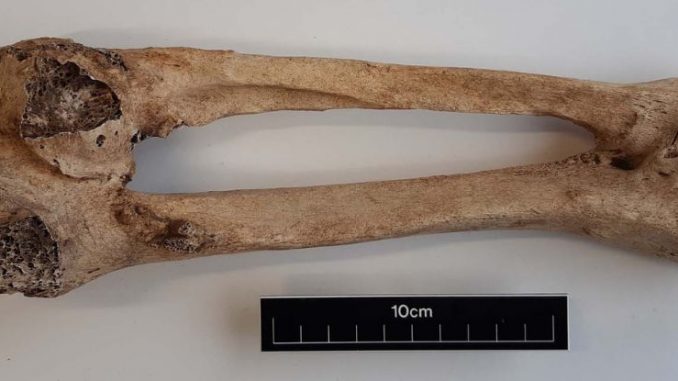Advertisement

In 2003, while building a motorway through a small community in Ireland, workers stumbled upon a long-lost medieval graveyard.
Of the approximately 1,300 bodies found at the site near Ballyhanna Township, some of the ancient burials stood out. Their bones were riddled with benign tumors caused by a rare disease, but for strangely different reasons.
Both individuals appeared to have a genetic condition known as multiple osteochondromas, which causes painful but typically non-cancerous tumors to grow in the bone, causing limb deformities, postural problems, or nerve damage over time.
We now know that the disease is far from common, affecting about 1 in 50,000 people. Finding two bodies with the condition in such a small cemetery is quite coincidental, especially since a genomic analysis of the remains was published in the European Journal of Human Genetics notes that the two men who left the bones were not closely related.
In fact, several centuries separated their lives in this small Irish community.
“We made several assumptions about these two men when we first discovered that they both suffered from multiple osteochondromas,” explains archaeologist Eileen Murphy of Queen’s University Belfast, a senior author of the study.
“We assumed they were contemporary, but radiocarbon dating showed they were several hundred years apart. We also assumed they were related, but new [ancient DNA] Analysis has shown that this is not the case.”
None of the skeletons unearthed at Ballyhanna’s Lost Cemetery look like they were in particularly good health when they died. Some show signs of tuberculosis or rickets.
But the bones of the two men with bony outgrowths were in particularly poor health.
Archaeologists suggest that the cemetery was once part of a lower-class medieval Gaelic community that included men, women and children. Some individuals were likely to be very poor, while others worked as farmers, laborers, merchants, artisans, or clergy.
The discovery of two unrelated men with the same rare bone disease in such a small community is unusual in itself, and it gets stranger.
Despite their similar appearance, recent analysis revealed that the two cases of multiple osteochondroma were not even caused by the same genetic mutation.
Both individuals showed changes in the EXT1 gene, which has been linked to multiple osteochondromas. But one of the mutations has never been seen in modern patients.
The first man had a missense mutation in part of his EXT1 gene, swapping a single nucleotide base for another, scrambling the coding sequence for the protein. It has previously been identified in at least three modern patients with multiple osteochondromas.
The second man showed a premature stop message in the same gene, which has not yet surfaced in modern sequencing data from patients with the disease.
The person with the novel mutation died at a younger age, around the age of 18 to 25, and had hip, knee, ankle and forearm deformities. He lived sometime between 1031 and 1260 AD.
The person who died at an older age, around 30 or 40, had less prominent tumors, but they were evident throughout the skeleton. He lived between 689 and 975 AD.
“It was really surprising that these individuals had completely different mutations that caused their condition, especially because it’s so rare,” says geneticist and first author Iseult Jackson of Trinity College Dublin.
The discovery just goes to show how much modern DNA analysis can reveal about diseases that have plagued us for millennia.
“The study demonstrates the important contribution that ancient DNA analysis of people from the past can make in understanding conditions that still affect people today,” said Dan Bradley, geneticist at Trinity College Dublin.
The study was published in European Journal of Human Genetics.

